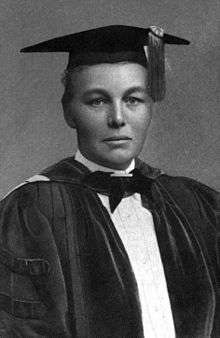Ida Helen Ogilvie
| Ida Helen Ogilvie | |
|---|---|
 | |
| Born |
February 12, 1874 New York City |
| Died |
October 13, 1963 (aged 89) Germantown, New York |
| Nationality | United States |
| Fields | Geology |
| Institutions | Barnard College |
| Alma mater | Columbia University |
|
Signature | |
Ida Helen Ogilvie (/ˈaɪdə ˈhɛlən oʊˈgɪlvi/) (born in New York City, February 12, 1874; died in 1963) was a United States educator and geologist.
Biography
Ida Helen Ogilvie was the daughter of Clinton and Helen Slade Ogilvie.[1] Her father Clinton was a landscape painter; her mother Helen was also a painter, and the daughter of Jarvis Slade. Ogilvie was educated at Brearley School and Bryn Mawr College, where she was graduated A.B. in 1900. While at Bryn Mawr she showed a marked aptitude for scientific research in geology and zoology. She studied under professor Florence Bascom who founded the Geology Department at Bryn Mawr.[1] She pursued her research studies in zoology for two summers at the Woods Hole Oceanographic Institution in Woods Hole, Massachusetts.
She eventually devoted herself to geology. She explored the Adirondacks, publishing her observations in a paper under the title of “The Glaciation of the Adirondacks.” Later she studied at Columbia, where she was awarded a Ph.D. in 1903. As a result of her graduate field work in 1901, she published a geological survey of Paradox Lake area in the Adirondack Mountains for the New York State Education Department.[2][3] Ogilvie's research contributions in past glaciation of the continent and volcanic activities are regarded as her most notable investigations. She explored the Canadian Rockies, north of the line of the railway, and added to her distinctions that of mountain climber, always as a scientific investigator.
She explored Popocatapetl, one of the highest volcanoes in Mexico, and reached the rim of the crater. She carried her investigations to the Ortiz Mountains of New Mexico, which belong to the laccolith type of extinct volcano. These explorations enabled her to announce to the scientific world many new facts in regard to the chemical relationship of lavas. She also published articles on the effect of aridity on erosion. She was one of the first investigators to establish the axiom that aridity has a notable effect upon the conflagration of the surface of the earth, and upon the composition of the sands and soil. She also studied the work of intermittent streams, and gave the name "conoplain" to the form of surface produced by the action of such streams.
Ogilvie's accounts of her excursions attracted immediate attention. From 1902-03, she taught geology in Misses Rayson's School, a private boarding school for young women, in New York. Her teaching methods in presenting geology to the girls made it interesting and easy to comprehend. In 1903, after receiving her Ph.D. degree, she was appointed lecturer of geology at Barnard College in New York City. This department of geology in Barnard College originated with Ogilvie's appointment. There, her success was even more pronounced, and she was steadily promoted, until she gained full charge of her department in 1911. She also lectured to classes in Columbia University.
She was a member of four major scientific communities; the Geological Society of America, the American Association for the Advancement of Science, the New York Academy of Science and the Seismological Society of America.
Publications
| Library resources about Ida Helen Ogilvie |
| By Ida Helen Ogilvie |
|---|
References and notes
- 1 2 Ogilvie, Marilyn; editors, Joy Harvey, (2000). The biographical dictionary of women in science : pioneering lives from ancient times to the mid-20th century. New York: Routledge. p. 958. ISBN 978-0415920407.
- ↑ Ogilvie, Ida Helen (1905). "Geology of the Paradox Lake Quadrangle, New York". New York State Museum Bulletin. Albany: New York State Education Department. 96 (10): 461–508. Retrieved 22 October 2014.
- ↑ Hulbe, Christina L.; Wang, Weili; Ommanney, Simon (2010-12-01). "Women in glaciology, a historical perspective". Journal of Glaciology. 56 (200): 944–964. doi:10.3189/002214311796406202.
 This article incorporates text from a publication now in the public domain: Homans, James E., ed. (1918). "Ogilvie, Ida Helen". The Cyclopædia of American Biography. New York: The Press Association Compilers, Inc.
This article incorporates text from a publication now in the public domain: Homans, James E., ed. (1918). "Ogilvie, Ida Helen". The Cyclopædia of American Biography. New York: The Press Association Compilers, Inc.
Further reading
- Elizabeth A. Wood (February 1964). "Memorial to Ida Helen Ogilvie (1874-1963)". Geological Society of America Bulletin. 75 (2): 35–40. doi:10.1130/0016-7606(1964)75[P35:MTIHO]2.0.CO;2.
External links
- "Barnard College Archives: The Barnard "Farmerettes" of World War I". barnardarchives.wordpress.com. December 1, 2009. Retrieved December 2011. Check date values in:
|access-date=(help)